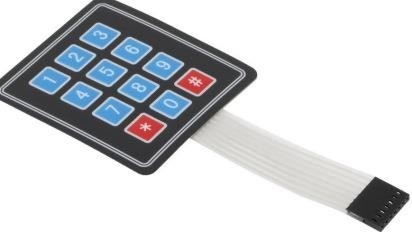Membrane Keypad
A membrane keypad is a type of input device commonly used in electronic projects for providing a simple, cost-effective way for users to interact with a system. It consists of multiple layers, typically including a flexible membrane with conductive traces, a spacer layer, and a bottom layer with corresponding conductive pads. When a key is pressed, it completes the circuit between the layers, sending a signal to the connected microcontroller, like an Arduino.
Membrane keypads are available in various sizes, with common configurations being 3x4 (12 keys) or 4x4 (16 keys). Each key in the keypad corresponds to a unique combination of rows and columns, which allows the keypad to be scanned by the microcontroller, reducing the number of input pins needed. The keypad is typically interfaced with a microcontroller via digital pins.
In Arduino-based projects, the Keypad library simplifies programming the membrane keypad for use in applications like password entry systems, user interfaces, control panels, and other input-driven systems. Membrane keypads are compact, durable, and widely used in appliances, security systems, and DIY electronics projects, providing an affordable solution for adding tactile input to a system. However, they may not be as durable or responsive as mechanical keypads in heavy-use applications.
Membrane keypads are available in various sizes, with common configurations being 3x4 (12 keys) or 4x4 (16 keys). Each key in the keypad corresponds to a unique combination of rows and columns, which allows the keypad to be scanned by the microcontroller, reducing the number of input pins needed. The keypad is typically interfaced with a microcontroller via digital pins.
In Arduino-based projects, the Keypad library simplifies programming the membrane keypad for use in applications like password entry systems, user interfaces, control panels, and other input-driven systems. Membrane keypads are compact, durable, and widely used in appliances, security systems, and DIY electronics projects, providing an affordable solution for adding tactile input to a system. However, they may not be as durable or responsive as mechanical keypads in heavy-use applications.
